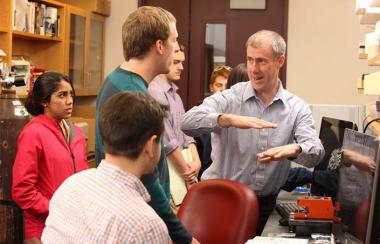Recent award-winning research from the University of Virginia’s Teaching Resource Center shows that tailoring teaching to how students learn improves courses and creates long-lasting impact.
Traditionally, the instructor’s focus was one-directional: delivering the content that needs to be covered, often centering on lectures, Palmer said. But how does an instructor know the students have really learned and not just done well (or poorly) on a test or paper?
Michael Palmer and Dorothe Bach, associate directors of the Teaching Resource Center, and graduate student Adriana Streifer developed a syllabus review tool that focuses on student learning. It may seem subtle, but research has shown the paradigm shift from information-delivered instruction to learning-centered instruction helps create the right environment for long-time learning and yields a more dynamic and engaging class, Palmer said.
“The ‘syllabus rubric’ was a brilliantly sneaky vehicle the TRC used to make unsuspecting professors ask ourselves really hard, really crucial questions about what our course intends to accomplish, not just with regard to the knowledge and skills conveyed, but in terms of its role in developing young professionals and lifelong learners,” Jerry Floro, associate professor of materials science and engineering in the School of Engineering and Applied Science, said after using it in redesigning one of his courses.
Palmer, Bach and Streifer were recently awarded the Professional and Organizational Development Network’s 2014 Innovation Award for this work. The article, “Measuring the Promise: A Learning-Focused Syllabus Rubric,” was originally published in the fall 2014 edition of the network’s flagship publication, To Improve the Academy: A Journal of Educational Development, and it has gained attention. The POD Network is the largest educational development organization in North America.
The “promising syllabus” – a phrase borrowed from educator Ken Bain, who defined it in 2004 as “a learning-focused document that communicates clearly and compellingly what students will gain from the course, what they will do to achieve the promise it lays out, how they will know whether they are getting there, and how to best go about studying” – helps instructors articulate how to create the right learning environment and have students actively participate in it, Palmer said.
“The data is quite compelling, and we were fortunate enough to present this to the Education Policy Committee at a recent U.Va. Board of Visitors meeting,” Palmer said.
“We have created a rubric [or standards of performance] to assess the degree to which a syllabus focuses on learning. The rubric provides qualitative descriptions of 16 components and uses a quantitative scoring system that places syllabi on a spectrum from content- to learning-focused,” Palmer said. “It is nuanced enough to provide summative information to developers using the tool for program assessment purposes and formative feedback to instructors interested in gauging the focus of their syllabi.”
The center has included the “syllabus rubric” in its Course Design Institute, a five-day intensive course during which faculty and graduate students design a new course or significantly redesign a course to focus on meaningful learning. The rubric can be applied to courses in any discipline.
“In general, Course Design Institutes aim to help instructors create rich, active classroom environments grounded in evidence-based practices; expand their pedagogical content knowledge; become reflective practitioners; and foster teaching community and personal growth,” Palmer said.
Brian Helmke and Michael Lawrence, both associate professors of biomedical engineering, designed a new nanomedicine laboratory using the syllabus rubric.
“The TRC syllabus rubric guided our thinking in course design by keeping the focus on learning goals for students rather than just a list of techniques or instruments to which students will be exposed,” Helmke said. They found the syllabus “encourages discussions of not just technical content in the class, but also ethics and other aspects of what it means to be a professional engineer,” he said.
Three years ago, Helmke also redesigned his “Biotransport” course in the Teaching Reseource Center’s Course Design Institute, a third-year class of approximately 95 students that is required for biomedical engineering majors, from lecture style to active learning.
“Assessments of learning have demonstrated that students who take advantage of the peer learning opportunities scored better than under the ‘old-style’ lecture class,” he said. “Maybe more importantly, a number of BME capstone (senior thesis) groups have returned in their fourth year to work with me as a consultant on aspects of their capstone projects related to the biotransport class. This never happened when the class was taught as a lecture, and it demonstrates that students are better incorporating the knowledge base into their working vocabulary.”
Here’s a sample from Helmke’s “Biotransport” course syllabus redesign.
Beginning of syllabus before using the TRC syllabus rubric
Objectives: To introduce principles and mathematics governing biological and biomedical transport processes; to apply classical engineering solutions and governing equations from simple transport problems to more complex biomedical transport processes; and to integrate knowledge of cell and organ physiology with mathematical expression of transport principles.
Beginning of syllabus after using the TRC syllabus rubric
Why should you care about Biotransport?
How can you deliver a drug to kill tumors without killing the patient? How can you harness nanotechnology to design inexpensive kits to diagnose diseases in low-resource countries? How do new blood vessels grow? These are examples of “grand challenges” faced by practicing biomedical engineers that require us to design mathematical and experimental approaches for predicting, measuring, and interpreting flow phenomena quantitatively. In this course, you will combine your knowledge of applied mathematics and human physiology from the molecule to cell to whole body length scales to begin exploring how to answer grand challenge questions such as these.
How will this course help you succeed?
Grand challenges are fundamental questions in biotransport with broad applications to science, engineering, and human health. This course will help you acquire a conceptual and practical framework that you can apply to solve complex grand challenges in your future research, engineering practice, or clinical practice.
Media Contact
Article Information
March 16, 2015
/content/building-better-course-starts-syllabus

